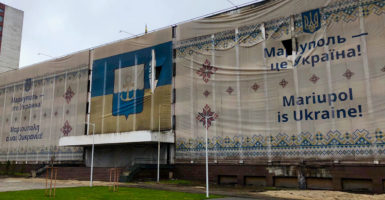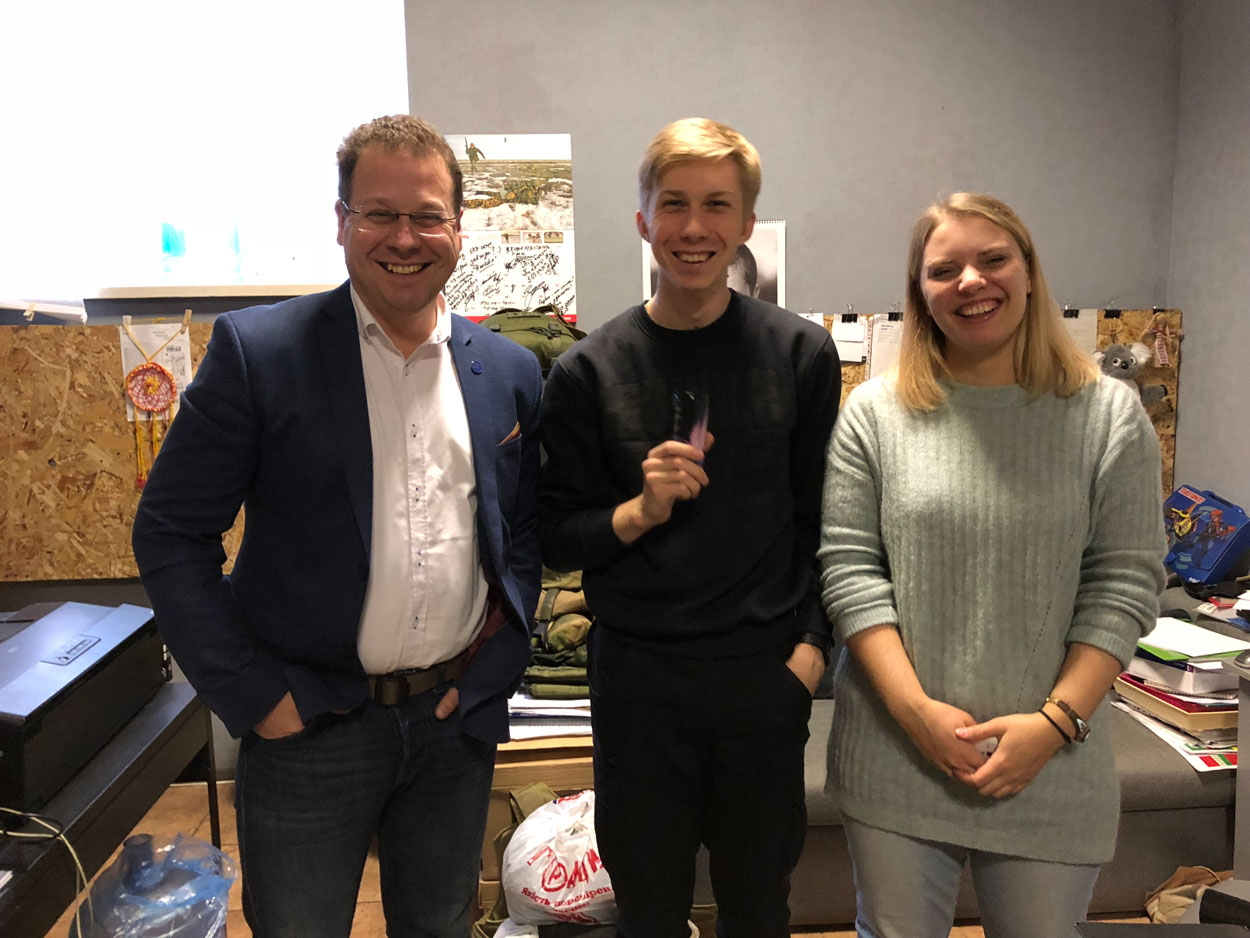MARIUPOL, Ukraine—The people of Mariupol have lived within earshot of Europe’s only ongoing land war for four and a half years. At first, they plainly showed fear at the sounds of the tank shots and the shelling. Now, they have the temerity to simply shake their heads and shrug their shoulders at the sounds of war.
“We still live in fear, but the war doesn’t affect us like it did in 2014 or 2015,” says 21-year-old Nikita Klimenchenko, a waiter at the Stone Restobar in Mariupol. “It’s an absurd way to live, but we’re used to it. The city is stronger, for sure.”
Winter in Mariupol can be a bit bleak. The sky is often gray, and a cold wind comes off the Sea of Azov, cutting through layers like the winter wind off Lake Michigan in Chicago.
On first impression, the city’s overall demeanor can seem as bleak as the winter weather. In some places, it seems as if people are simply squatting in the leftovers of the Soviet Union.
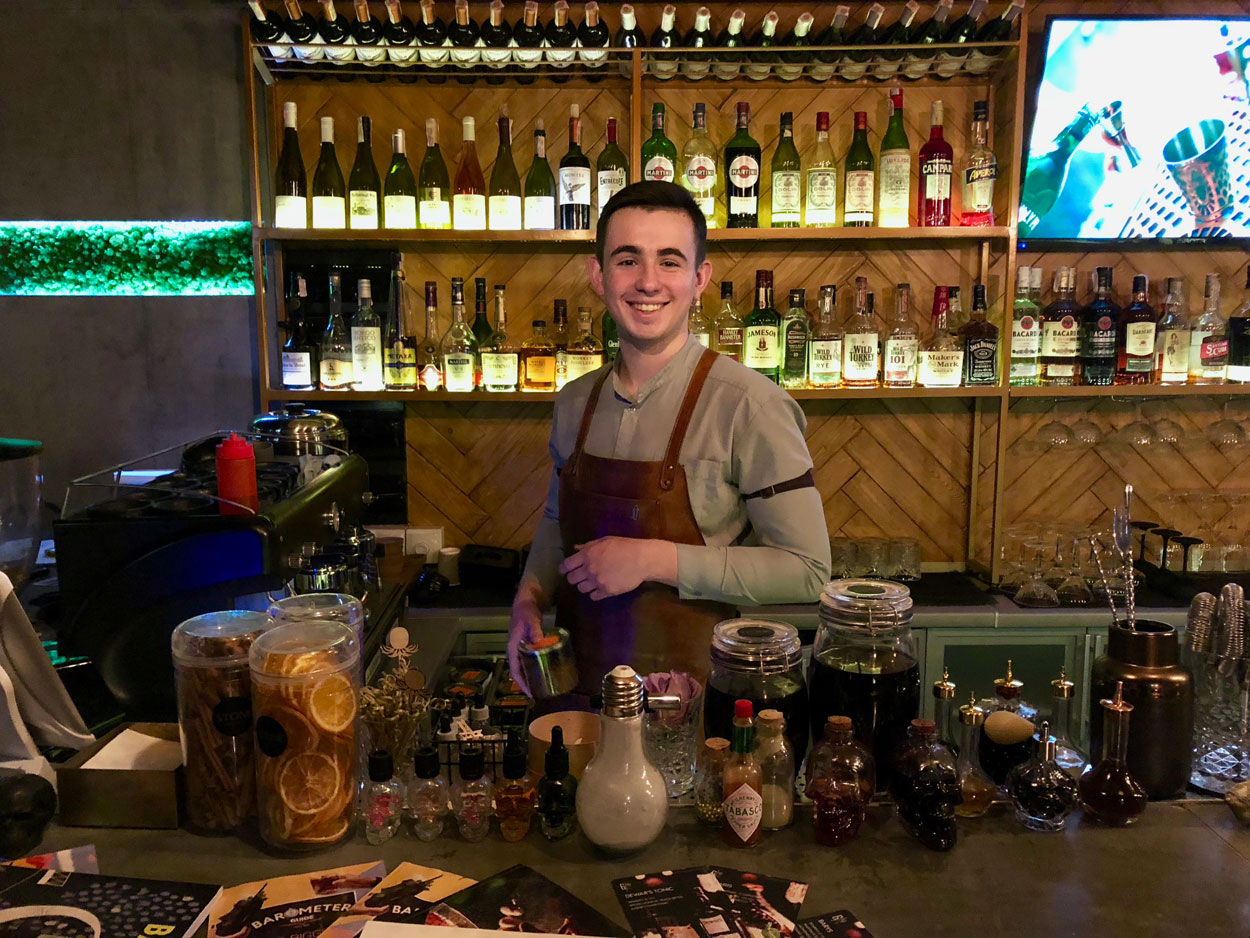
Nikita Skidkov, 19, says he’s used to the war on Mariupol’s doorstep. “We hear the shooting, we know it’s there, but we’re not afraid,” he says. (Photos: Nolan Peterson/The Daily Signal)
Thus, by the look of the city, a first-time foreign observer might assume that the city’s tired, Soviet-era architecture and infrastructure reflect a correspondingly downtrodden or war-weary population. But you’d be wrong. In fact, many of Mariupol’s residents would tell you something altogether different, which might surprise you.
“From a material point of view, in terms of finances and investments, yes, the war has been negative,” says Oleh Kharchenko, 49, a civil society activist in Mariupol.
“But our morale has improved,” Kharchenko says. “We’re now more aware of our national identity. We’re Ukrainians in our hearts.”
Not only has the war steeled the nerves of Mariupol’s residents. It has also pushed Mariupol’s democratic evolution over the tipping point, spurring the city’s civil society to flourish in a way it never did in the interim between the fall of the Soviet Union and the war’s outset in 2014.
“The war has helped to build Mariupol’s civil society. Perhaps it’s bad, but it’s true,” says Petro Andryushchenko, 43, a Mariupol businessman and political reformer.
“Our whole history is a fight for freedom,” Andryushchenko says. “It’s been our dream to have a country like we have today. And we must do more.”
Hope
On a blustery December night with a light rain that’s freezing on the sidewalk, you walk up Mariupol’s main thoroughfare of Peace Avenue—originally “Lenin Avenue,” it was renamed after the war began.
Walking, you pass a series of hip new restaurants and bars that didn’t exist before the war. Down a side street, there’s a restaurant called Pizza Veterano, which delivers pizzas to troops entrenched on the front lines about 6 miles east of the city limit.
You continue on past Theater Garden, where new modern art displays glow under lights amid the tended landscapes, and head up toward newly renovated Greek Square.
(Mariupol was founded by Greek settlers. Today, there are about 22,000 ethnic Greeks living in Mariupol out of an overall population of half a million.)
Standing on Greek Square, Mariupol’s city administration building looms over you. The structure remains a burnt-out ruin from urban combat in 2014. Yet, a fabric façade now covers the building’s front face. On it, the words “Mariupol is Ukraine” are written in Ukrainian, Russian, Greek, and English.
Then you turn down University Street and make your way to the Stone Restobar. This modern restaurant opened after the war began. It has a smart interior, eclectic menu, and excellent craft cocktails. Behind the bar, 19-year-old barman Nikita Skidkov is quick to make his trademark drink, the brandy-based “Trader.”
When asked if he worries about the war, Skidkov simply shrugs his shoulders and says, “It’s normal. We hear the shooting, we know it’s there, but we’re not afraid.”
He was 14 when the war began.
As you sip on your cocktail at this stylish spot in the city center, it’s easy to forget you could drive from there to the trenches in about 20 minutes. It’s hard to imagine, but it’s true. The war is there. It’s real, even if the war’s presence has become part of the normal background din to everyday life in Mariupol.
Fighting raged in the streets in May and June of 2014, when Ukrainian forces retook the city after a brief seizure by Russian-sponsored separatist forces. In September 2014, after regular Russian military units had entered the war outright, tank battles on Mariupol’s outskirts rattled windows in the city center.
The population braced for a siege. But a last-ditch cease-fire, signed Sept. 5, 2014, spared Mariupol, stalling the conflict about 6 miles east of the city limits. That’s about where the front lines remain fixed today.
The operative Minsk II cease-fire—signed in February 2015—has effectively locked the conflict along its current geographical boundaries. But the war never ended. Ukraine’s military continues to fight against a combined force of pro-Russian separatists, foreign mercenaries, and Russian regulars.
About 10,300 Ukrainians have so far died in the conflict. And there are still daily casualties, both civilian and military.

From left to right: Petro Andryushchenko, Roman Amelyakin, Kyrylo Vyshnyakov, and Oleh Kharchenko—all civil society activists in Mariupol.
It’s a halfhearted, long-range battle, fought from trenches and ad hoc forts, marked by daily shelling and small arms gunfights. At some places, no man’s land can be several kilometers wide. At others, the two camps are close enough to shout insults at each other.
The war casts a constant shadow over life in Mariupol. Occasionally, with deadly consequences.
Such as in January 2015, when a Grad rocket attack launched by Russian-controlled forces hit a civilian neighborhood, killing 29.
Or on Oct. 4, 2014, when a combined Russian-separatist Grad rocket attack killed seven people during a funeral procession in the outlying village of Sartana, about 6 miles from Mariupol’s city center.
Or in August 2015, when combined Russian-separatist shelling killed three more people in Sartana.
Today, Mariupol’s civilians have memories of gun battles and know firsthand the sounds of heavy weapons and artillery.
The combat veterans—most of whom are in their 20s or 30s—recall the fear of trench warfare. The whistle of an incoming mortar, the high-gain crack of exploding shells, the way Grad rockets fall like some kind of hellish rain.
Combat teaches lessons that instincts don’t forget in peace. You leap at the sound of a car door slamming. A man whistles at his dog; your brain hears the sound of an incoming mortar and your body reacts.
Soldiers often struggle to move on with their lives after coming home from war. It’s even harder when the war you fought in is only a 20-minute car ride away. Still, for some of Mariupol’s veterans, the war’s proximity imparts a continued sense of purpose and duty to their civilian lives.
“I consider what I’m doing now to be just as important as what I did as a soldier,” says Roman Amelyakin, 39, a war veteran who is now an elected deputy on the Mariupol City Council.
“As a soldier on the front line, we defended the motherland from our enemies,” Amelyakin says. “Now, as a politician, I’m fighting to build a country for the future, which all Ukrainians can believe in. We want to create a country worth living in—for people on both sides of the front lines.”
For Mariupol’s older residents, whose mindsets were shaped by life in the Soviet Union or the post-Soviet chaos of the 1990s, the ongoing war is the latest trial in a lifetime of hard times. For those older generations, it’s hard to believe things will get better.
For Mariupol’s millennials, however, the Soviet Union is a secondhand memory, and they were too young to truly comprehend the perils of the 1990s. Consequently, the younger generations retain an expectation that their lives will improve—and those expectations are the catalyst for social and political change.
“In many ways, the younger people are getting rid of the Soviet mindset,” Klimenchenko, the 21-year-old waiter at Stone Restobar, says in soft-spoken English.
“We are more open-minded, more politically aware, and more aware of things going on around the world,” he says.
When asked if he believes Ukraine will achieve what it is fighting for in his lifetime, Klimenchenko replies: “I sometimes have hope, although it’s hard. The war has gone on for too long.”
The young man then pauses for a beat, as if searching for an idea that’s hard to express in any language.
“But it’s important to have hope,” he adds.
Battle Hardened
Immediately following Ukraine’s 2014 pro-Western revolution, Russia invaded and seized Ukraine’s Crimean Peninsula. Then, Russian military and intelligence forces engineered a war in Ukraine’s eastern Donbas region.
As the summer of 2014 wore on, Russia sent its own regular, armored forces into the conflict.
With the city under threat of a siege in the summer of 2014, Mariupol’s civilians launched a grassroots war effort to shore up the city’s military defenses as well as its pro-Ukrainian spirit.
The wartime volunteer movement was a spontaneous manifestation of civil society, underscoring a widespread attitude of self-reliance among residents who were unwilling to wait for the government to act in a moment of crisis.
At that time, volunteers brought supplies out to Ukrainian soldiers entrenched on the city’s outskirts. Local workers helped the soldiers dig trenches and tank blinds. Some volunteer groups led military training camps, preparing civilians for urban warfare.
The civic group New Mariupol organized a human chain on the outskirts of the city as a symbolic call to end the war. The event drew more than 1,000 people. On Sept. 4, 2014, amid ongoing fighting on Mariupol’s outskirts, a pro-Ukraine rally in the city center drew thousands.
“Volunteers took responsibility for the fate of Mariupol in 2014,” Amelyakin says.
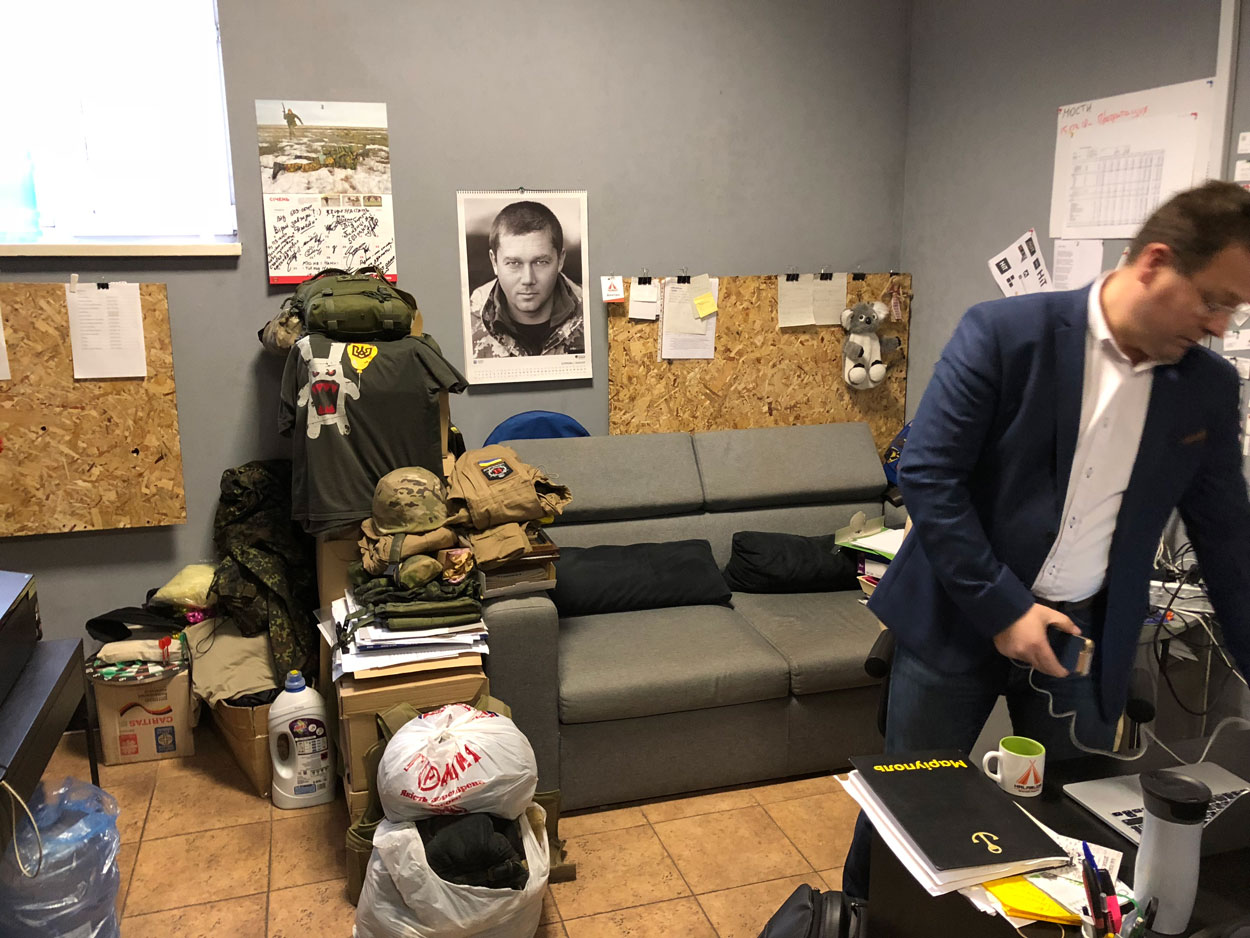
The office of Dmitry Chichera, a volunteer leader and civil society activist in Mariupol, evidences the city’s grassroots war effort.
Prior to the war, many were reluctant to participate in their city’s politics or social movements. They had adopted what is colloquially known in Ukraine as the Soviet-era “ostrich mentality”—best keep your head down and out of trouble; it’s not worth being singled out trying to effect change that most likely won’t succeed.
Today, Mariupol’s civil society activists say the grassroots volunteer movement that helped spare the city from military disaster in the summer of 2014 has paved the way for the city’s democratic civil society to flourish in a way it never had prior to the war.
“I want to live in a new Ukraine right now. I want my children to live in a new Ukraine right now,” says Kyrylo Vyshnyakov, 36, a former Mariupol restaurant manager who is now a political activist.
“But we understand that no one will come and do this work for us,” Vyshnyakov says. “So, as the saying goes, if not us, then who?”
The threat of a full-scale Russian sack of Mariupol has faded, and Ukraine’s military is no longer the ragtag force it once was. Therefore, volunteers who once made shell-dodging supply runs to soldiers entrenched on the front lines are now refocusing on long-term, pro-democracy projects, which they say are equally as important to Ukraine’s future as the ongoing war effort.
“Our soldiers don’t need our help like in 2014, so we can focus on other things,” Amelyakin says. “The volunteers gave rise to our civil society. Now, we continue our fight. And we have one enemy—the legacy of the Soviet Union.”
Creative Space
When the war began in 2014, Mariupol photographer Dmitry Chichera spearheaded creation of a volunteer group that delivers supplies to front-line soldiers and provides aid to civilians displaced by the fighting.
After four and a half years, Chichera’s operation evolved into a civil society development project.
“We’re turning the corner from humanitarian work to education work,” Chichera says. “The war isn’t over, but our challenge is no longer to just defend our country, we have to repair it, too. We have a more long-term approach.”
Two years ago, Chichera turned an old gym into a shared workspace for Mariupol’s entrepreneurs. He named the project “Halabuda.”
With the help of a grant from the U.S. Agency for International Development, Chichera renovated the old gym into a hip, modern space with multiple classrooms. Today, Halabuda’s six full-time staff members organize about 200 events a month, drawing roughly 2,000 people.
They have English classes, art classes, entrepreneur clubs, and even post-traumatic stress counseling for soldiers and civilians alike. There’s a summer camp in which schoolchildren learn about government.
Chichera also spearheaded a program called Building Bridges, which facilitates dialogue between civilians and local government. Along that line of thinking, Chichera says every police officer in Mariupol can get a free cup of coffee at Halabuda.
“There was nothing like this in Mariupol before the war,” Chichera says. “The volunteers created Mariupol’s civil society. And it’s still going on.”
Halabuda has the feel of a Silicon valley startup—that is, until you go into Chichera’s office and observe the walls lined with military kit. From here, Chichera continues to run his ongoing volunteer drive for soldiers and civilians in the war zone.
“The war isn’t over, but we have to look past it,” Chichera says. “I always believed in a better future for Ukraine. Actually, I don’t just hope for it, I’m sure it will happen. If we work hard enough.”
Martial Law
A Nov. 25 naval confrontation with Russia in the Black Sea near the Kerch Strait spurred Ukraine to put its military on full alert and declare martial law in 10 border territories deemed most vulnerable to a Russian invasion.
Mariupol is in one of those regions under martial law, but you’d hardly know it.
“Nothing changed at all,” Klimenchenko says. “Life is totally normal.”
Ukraine’s national security doctrine is a mix of conventional military force with the use of irregular, civilian territorial defense forces. Thus, officials say that declaring martial law in those regions most vulnerable to a Russian attack puts Ukraine on a fast-tracked war footing.
Amelyakin, a military veteran, says that after martial law went into effect, the military reserves phoned him to determine if he was fit for duty.
Kyiv’s hurried rollout of the martial law measure left many Ukrainians in the dark about its details. Despite initial misgivings, however, some people in Mariupol have warmed to the idea of martial law since its adoption.
“We’re glad that the martial law idea came to our government,” says Vyshnyakov, the restaurant manager-turned-political activist. “We were afraid that [Russian President Vladimir] Putin could attack and start a really big war—much bigger than what we’ve got already. Today, we think that Putin changed his mind because of the martial law.”
Civil Society
At a meeting in a humid cellar on a stormy night in July 2015, this correspondent was on hand as the leaders of a pro-democracy community group called Together lectured an audience of Mariupol’s residents on the basic tenets of democratic culture.
“Mariupol is caught between the past and the future,” Andryushchenko said on that night in 2015. “The City Council site must be open and accessible by all. When we control the local government, we control our own money. So we have a right to control these activities.”
“How can you control the authorities?” interjected one old, gray-bearded man from the crowd. “You are ambitious young people, but you won’t be able to change anything.”
Three and a half years later, Andryushchenko says that old man has been proven wrong.
“Even with the war, we changed our town, we changed our local authorities,” Andryushchenko says during a Dec. 6 interview in Mariupol. “We can teach other people in Ukraine—if we can change our cities, we can change our country.”
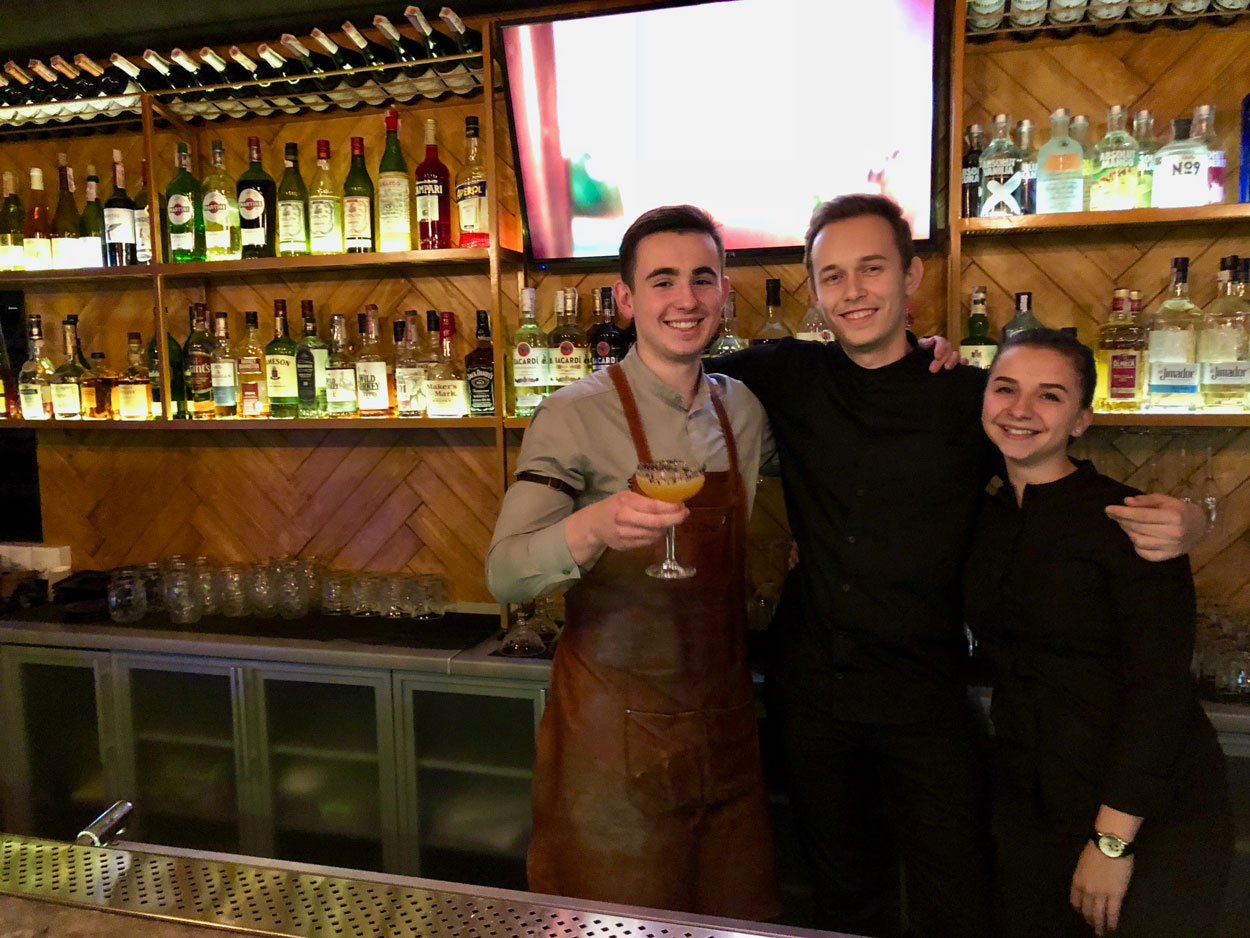
The staff at the Stone Restobar in Mariupol. From left to right: Nikita Skidkov, Nikita Klimenchenko, and Liza Kundel.
For one, average salaries in Mariupol more than doubled in the period from the middle of 2016 to the end of 2017, the city’s mayor reports.
Moreover, Mariupol’s municipal government is among the most transparent in Ukraine, according to an ongoing study by Transparency International Ukraine, an accredited arm of the international, anti-corruption nongovernmental organization Transparency International.
As part of its 2-year-old Transparent Cities Project, the organization periodically ranks Ukraine’s 100 biggest cities based on their governmental transparency. The index measures things such as budget procurement, education, land use, anti-corruption efforts, and communication between civilians and their local governments.
In November, Mariupol held second place on the transparency index—up from 57th place two years ago.
“As far as we know, there are many young people working in Mariupol’s City Council—active and promising youth. Initiatives are welcome in the City Council and staff members are motivated,” Alina Kobenko, communications manager for Transparency International Ukraine, tells The Daily Signal.
Of course, Mariupol’s wartime transformation has not been uniformly positive.
Buildings across Mariupol still bear battle scars, and some residents still grumble about the fact that the city’s one McDonald’s restaurant was shuttered when the war began.
Ukraine’s post-revolutionary economic downturn has hit some quarters of the city hard, and many area officials now worry that Russia’s de facto blockade of Ukrainian commercial shipping in the Sea of Azov poses a long-term economic threat to the area.
“Mariupol is moving in the right direction,” Vyshnyakov says. “But we haven’t hit the point of no return. We worry that more sacrifices might be needed.”
Also, as in Soviet times, the linchpins of Mariupol’s economy remain: the Ilyich Iron and Steel Works and the Azovstal Iron and Steel Works plants. Environmental protection standards remain dismal, and pollution is a top concern for many of Mariupol’s residents.
“I don’t want to live in Mariupol for one reason—the pollution,” says 21-year-old Liza Kundel. “It’s getting better, but too slowly.”
The Musketeers
About a year into the war, Together, the pro-democracy community group, joined forces with a group of volunteers who were supporting front-line troops.
The organizations united their efforts under the banner of an upstart, reformist Ukrainian political party called Power of People. Their goal was to translate their local volunteer work and civic activism into seats on the Mariupol City Council.
They’ve elected five deputies so far. Amelyakin, the war veteran, is among them.
“We realized that as a civil society activist you don’t have the tools to truly change government. So we decided to run for office,” Amelyakin says.
Mariupol’s City Council has 54 seats, so five deputies isn’t enough to spearhead a sweeping political overhaul. But those five deputies are empowered and energetic. They call themselves the “musketeers,” and they’ve already pushed through a few initiatives to help bridge the Soviet legacy divide between civilians and their government.
Those measures include an online petition platform and a call center for residents to report their concerns to the City Council. The council has also adopted a “participatory budget,” in which a portion of the city’s annual spending is set aside for projects proposed by residents.
“We need changes. We need new faces, new ideas, new ways of thinking,” says Andryushchenko, who is now working for Mariupol’s chapter of the Power of People party.
“Yes, the war changed us. We were reborn,” Andryushchenko adds. “But we still need to change so many things. Maybe, this is our last chance.”



























